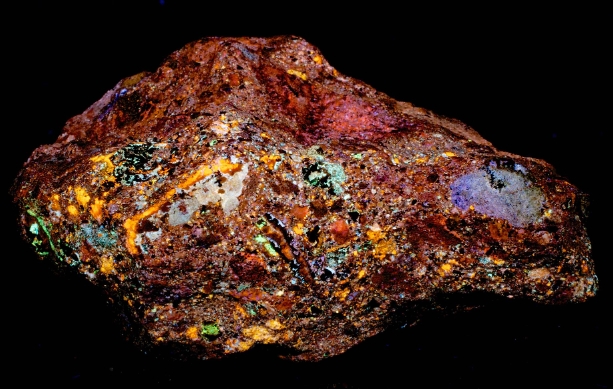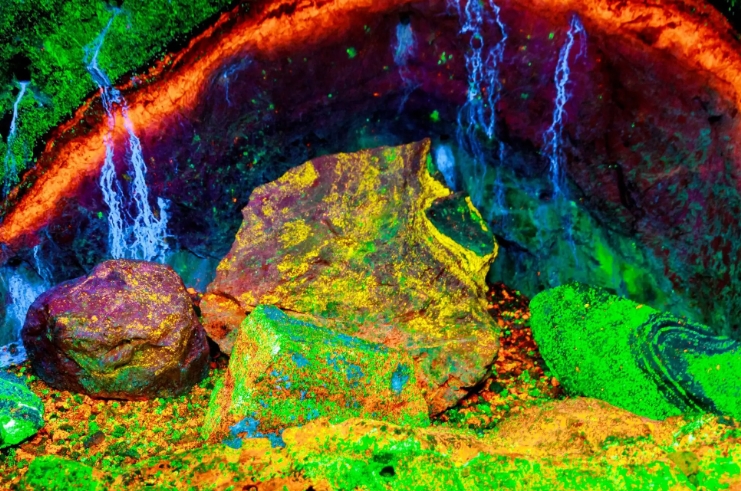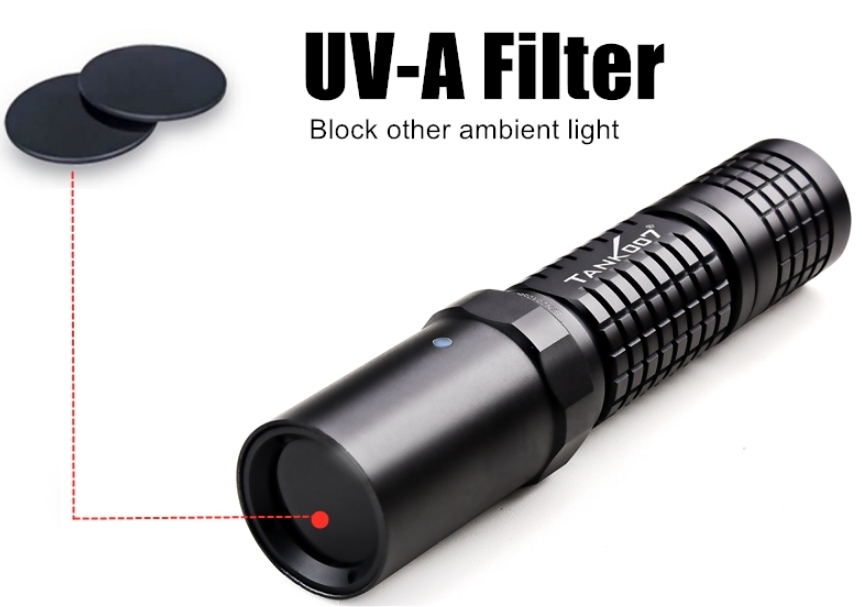The post Why Do Some Minerals Glow Under UV Light? appeared first on Tank007.
]]>1. The Science Behind Fluorescence in Minerals

Fluorescence occurs when a mineral absorbs UV light and then emits visible light as electrons return to their original energy levels. The emitted light is often a different color than the absorbed UV light, producing the glow that we see.
Key Steps in Fluorescence:
- Absorption: UV light excites electrons in the mineral.
- Transition: Excited electrons move to higher energy levels.
- Emission: As electrons return to lower levels, they release energy as visible light.
Summary: The glow is a result of electrons releasing energy in the form of visible light after being excited by UV radiation.
2. Types of UV Light and Their Effects
There are three main types of UV light that influence mineral fluorescence:
| Type of UV Light | Wavelength Range | Effect on Minerals |
|---|---|---|
| UV-A (Longwave) | 320–400 nm | Common in UV flashlights, causes soft glow. |
| UV-B (Midwave) | 280–320 nm | Rarely used, can cause moderate fluorescence. |
| UV-C (Shortwave) | 100–280 nm | Most effective for bright fluorescence in minerals. |
Recommendation: For mineral enthusiasts, a UV-C (shortwave) flashlight is ideal due to its ability to reveal vibrant fluorescence.
3. Why Only Some Minerals Glow: The Role of Activators
Not all minerals fluoresce under UV light. The presence of certain activator elements is essential for fluorescence to occur.
| Activator Elements | Examples of Minerals | Fluorescent Colors |
|---|---|---|
| Manganese (Mn2?) | Calcite, Rhodonite | Red, pink, or orange |
| Uranium (UO2?) | Autunite, Uranophane | Green or yellow-green |
| Lead (Pb2?) | Willemite, Scheelite | Blue or green |
| Rare Earth Elements (REEs) | Fluorite, Apatite | Blue, green, or yellow |
Summary: The presence and type of activators significantly affect the fluorescence color and intensity.
4. The Role of Crystal Structure in Fluorescence
Crystal structure impacts how UV light is absorbed and re-emitted:
- Highly ordered crystals: More likely to fluoresce due to uniform paths for electron movement.
- Disordered or impure crystals: Less likely to fluoresce effectively.
| Crystal Type | Fluorescence Likelihood | Examples |
|---|---|---|
| Cubic (Isometric) | High | Fluorite, Halite |
| Hexagonal | Moderate | Apatite, Beryl |
| Amorphous | Low | Opal, Obsidian |
Conclusion: Minerals with more structured and uniform crystals exhibit stronger fluorescence.
5. Comparison of Fluorescent vs. Non-Fluorescent Minerals

| Aspect | Fluorescent Minerals | Non-Fluorescent Minerals |
|---|---|---|
| Activator Elements | Present (e.g., Mn, Pb, REEs) | Absent or insufficient |
| Crystal Structure | Highly ordered | Often disordered |
| UV Light Reaction | Glows under UV light | No glow or very faint |
| Examples | Calcite, Fluorite, Willemite | Quartz, Feldspar, Hematite |
Summary: The presence of activator elements and crystal structure quality distinguish fluorescent minerals from non-fluorescent ones.
6. Common Fluorescent Minerals and Their Colors
| Mineral | Common Activator | Fluorescence Color |
|---|---|---|
| Fluorite | Rare Earth Elements | Blue, green, or yellow |
| Calcite | Manganese | Red, pink, or orange |
| Willemite | Zinc or Lead | Green |
| Scheelite | Molybdenum | Blue-white |
Tip: Knowing the activator can help predict the fluorescence color of a mineral.
7. Why Some Minerals Do Not Fluoresce
Non-fluorescent minerals lack the essential activator elements or have impurities that absorb UV energy without re-emitting visible light.
Common Reasons for Lack of Fluorescence:
- Absence of activators: No elements to facilitate light emission.
- Presence of quenchers: Elements like iron (Fe) can absorb UV energy without emitting light.
- Disordered crystal structure: Prevents uniform electron transitions.
Conclusion: The lack of appropriate activators or the presence of quenchers is why many minerals do not fluoresce.
8. Practical Applications of Fluorescent Minerals
| Application | Purpose | Example Minerals |
|---|---|---|
| Mining | Identifying ore bodies | Scheelite (for tungsten), Willemite (for zinc) |
| Geology and Fieldwork | Mineral identification | Fluorite, Calcite |
| Gemstone Authentication | Detecting fakes and enhancements | Diamond, Ruby |
| Collecting and Education | Display and learning | Various fluorescent minerals |
Summary: Fluorescent minerals have practical uses in mining, geology, and gemstone authentication.
9. Tips for Viewing Mineral Fluorescence
- Choose the Right UV Light:
- Preferably UV-C (shortwave) for vibrant fluorescence.
- Dark Environment:
- Perform observations in complete darkness for best results.
- Use Protective Gear:
- Avoid direct eye exposure to UV light.
- Keep Minerals Clean:
- Dust and grime can block UV light absorption.
Conclusion: Proper tools and a controlled environment enhance the visibility of mineral fluorescence.
10. Summary: Key Factors for Fluorescence in Minerals
| Key Factor | Importance | Recommendation |
|---|---|---|
| UV Wavelength | Determines visibility of fluorescence | Use 254 nm (UV-C) for best results. |
| Activator Elements | Essential for light emission | Check for Mn, Pb, or REEs. |
| Crystal Structure | Affects light absorption and emission | Prefer highly ordered crystals. |
| Absence of Quenchers | Prevents energy loss without light | Avoid minerals with high iron content. |
Conclusion: Understanding these key factors can help enthusiasts and professionals identify and appreciate the beauty of fluorescent minerals effectively.
The post Why Do Some Minerals Glow Under UV Light? appeared first on Tank007.
]]>The post What is UV Light and How Does It Interact with Minerals? appeared first on Tank007.
]]>Ultraviolet (UV) light is a type of electromagnetic radiation with wavelengths shorter than visible light but longer than X-rays. It plays a crucial role in various scientific, industrial, and recreational applications, including the study and identification of minerals. UV light interacts with minerals in unique ways, often causing them to fluoresce, phosphoresce, or reveal hidden characteristics. This article explores the science behind UV light, its interaction with minerals, and the principles that govern this fascinating phenomenon.
1. Understanding UV Light
| Type of UV Light | Wavelength Range (nm) | Common Applications |
|---|---|---|
| UVA (Longwave) | 320–400 | Mineral identification, counterfeit detection |
| UVB (Midwave) | 280–320 | Medical treatments, sterilization |
| UVC (Shortwave) | 100–280 | Sterilization, laboratory research |
- UVA (Longwave UV Light): Most commonly used for mineral inspection because it is safer and widely available.
- UVB (Midwave UV Light): Less common but sometimes used for specialized mineral studies.
- UVC (Shortwave UV Light): Highly energetic and used for detecting rare fluorescent minerals but requires protective measures.
2. How UV Light Interacts with Minerals
When UV light strikes a mineral, several interactions can occur:

a. Fluorescence
- Some minerals absorb UV light and re-emit it as visible light.
- Example Minerals: Fluorite, Calcite, Willemite.
b. Phosphorescence
- Certain minerals continue to emit visible light even after the UV source is removed.
- Example Minerals: Sphalerite, Willemite.
c. Absorption and Reflection
- Some minerals absorb UV light without re-emitting visible light.
- Others may reflect UV light, creating a unique appearance.
| Interaction Type | Description | Examples |
|---|---|---|
| Fluorescence | Emits visible light under UV exposure | Fluorite, Calcite |
| Phosphorescence | Continues emitting light after UV source is removed | Willemite, Sphalerite |
| Absorption | UV light is absorbed without visible emission | Certain Quartz Variants |
| Reflection | UV light reflects off the surface | Specific opaque minerals |
3. Factors Affecting UV Light Interaction with Minerals
- Mineral Composition: Specific chemical elements or impurities can trigger fluorescence.
- Wavelength of UV Light: Different minerals respond to UVA, UVB, or UVC light uniquely.
- Presence of Activators: Elements like manganese, lead, and uranium act as activators for fluorescence.
Common Fluorescent Activators in Minerals
| Activator Element | Fluorescent Effect | Example Mineral |
|---|---|---|
| Manganese (Mn) | Red or pink glow | Calcite |
| Lead (Pb) | Blue or white glow | Scheelite |
| Uranium (U) | Green glow | Autunite |
4. Applications of UV Light in Mineral Identification

a. Gemology:
- Identify genuine gemstones vs. synthetic ones.
- Detect treatments or enhancements on gems.
b. Mining Exploration:
- Locate fluorescent ore deposits in rocks.
c. Education and Research:
- Teach students about mineral properties.
- Conduct geological research.
d. Hobby and Collecting:
- Mineral collectors use UV lights to highlight rare specimens.
5. Tools for UV Mineral Inspection
- UV Flashlights: Portable and convenient for field inspections.
- UV Lamps (Shortwave and Longwave): Used in controlled environments.
- Protective Equipment: UV safety goggles and gloves are essential.
6. Practical Example: Using a UV Flashlight for Mineral Inspection

Step 1: Choose the appropriate UV wavelength (UVA or UVC).
Step 2: Ensure the inspection area is dark.
Step 3: Shine the UV flashlight on the mineral sample.
Step 4: Observe and record fluorescence or phosphorescence effects.
Step 5: Compare findings with reference mineral charts.
| Tool | Recommended Wavelength | Application |
|---|---|---|
| Handheld UVA Flashlight | 365 nm | General fluorescence inspection |
| Shortwave UV Lamp | 254 nm | Rare mineral fluorescence |
7. Conclusion
The interaction between UV light and minerals opens up fascinating opportunities for identification, exploration, and education. By understanding the different UV wavelengths, fluorescence mechanisms, and tools available, professionals and hobbyists alike can make the most out of UV light technology.
Whether you are identifying a rare fluorescent gemstone, exploring ore deposits, or simply enjoying the vibrant glow of minerals under UV light, the science behind this interaction is both valuable and captivating.
Enhance your mineral inspection capabilities with high-quality UV flashlights today!
The post What is UV Light and How Does It Interact with Minerals? appeared first on Tank007.
]]>